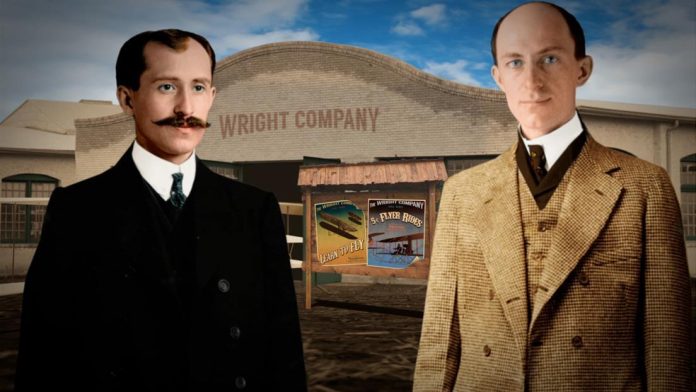
There Is No Flying Without Wings – The Aviation story of Wright Brothers
Date:

Share post:

The end of the 19th century marked the beginning of aviation history. In May 1896, Smithsonian Institution Secretary Samuel Langley flew an unmanned steam-powered fixed-wing model aircraft. In the following months’ Octave Chanute, from Chicago tested gliders over the dunes of the shore of Lake Michigan. Around the same time, Lilienthal while trying to fly a glider got killed in the plunge of his glider. These people and their incidents prompted the Wright Brothers to further pursue their flight research from the back room of their bicycle shop-Wright Cycle Company in Ohio. In May 1899, Wilbur Wright wrote to the Smithsonian Institution to share the work of Sir George Cayley, Chanute, Otto Lilienthal, Leonardo da Vinci, and Langley, the precursors of aviation. The Wright Brothers were about to write aviation history.

Inquisitive Minds
The inquisitive minds of Orville and Wilbur opened up in 1978, when their father bought them a 50 cent helicopter. The toy, designed by French aeronautical pioneer Alphonse Pénaud made from paper, bamboo, and cork with a rubber band to twirl its rotors fascinated both the brothers so much that it spiked their interest in flying.
Wilbur (born April 16, 1867) and Orville (born August 19, 1871) grew up with five siblings Reuchlin, Lorin, Katharine, and twins Otis and Ida. Since their father Milton, worked as a bishop in the United Brethren Church in Christ, the family had to move 12 times before they finally returned and settled in Dayton, Ohio in 1884. Due to this both brothers only attended High School and never went to college or got a diploma. Their mother Susan was known to profess an innovative mind, often making custom toys for her children. Influenced by their mother, the young Wright brothers would dream of innovation and discovery from an early age. The 50 cent toy helicopter proved to be that key.

The Flight to Success
From a printing press to a bicycle shop to designing gliders, the Wright brothers were on the path to becoming the most well-known American innovators. On October 8, 1902, the Wright Brothers achieved a major milestone when they succeeded in controlling their glider with a steerable rudder. From September 19 to October 24, 1902, the brothers did between 700 and 1,000 glides, the longest lasting 26 seconds and covering 622.5 feet (189.7 m).
On December 17, 1903, on the dunes of Kitty Hawk, North Carolina, the Wright brothers Orville and Wilbur along with few friends came to witness ‘ Wright Flyer’, the first mechanical contraption of spruce wood, muslin fabric, and a gasoline engine take flight. With Orville Wright piloting and Wilbur Wright running at wingtip their invention took to the sky at 120 feet above ground at a speed of 6.8 miles per hour and lasted for exactly 12 bumpy seconds. The Wright Brothers knew they had succeeded in years of hard work and research to build a plane. They had successfully invented, build, and flown the world’s first successful motor-operated airplane. These 12 seconds would finally give wings to mankind.


In 1904-05, the brothers continued to improvise their flying machine finding ways to make it more aerodynamic giving flight to the Wright Flyer II. What followed was the Wright Flyer III, the first practical fixed-wing aircraft. With this the Wright brothers had become expert flyers, and invented the three-axis control system, to enable a pilot to steer the aircraft in any direction while maintaining its equilibrium. From the beginning of their aeronautical work, the Wright brothers along with their employee Charlie Taylor, focused on designing more efficient wings and propellers. Interestingly, their first U.S. patent for a ‘Flying Machine’ on March 23, 1903, was not for inventing the flying machine, but for a system of aerodynamic control that manipulates the flying machine’s surfaces. It was the true invention of the airplane. They even formed a company called ‘Wright Company’ to protect this invention.

The flight to the future
Between 1906 and 1907, the Wright brothers made no flights and spend much of their time trying to sell their flying machines to European and American governments. When the U.S. military expressed no interest to buy the flying machine or contract with the Wright Company, Will and Orville along with their sister Katherine traveled to France in 1908 where enthusiasm for aviation ran high and people began to notice their invention. The French and British governments were keen on purchasing the Wrights’ Flyers. Before the trip, Orville shipped a newly built Model A Flyer to France in anticipation of demonstration flights. During their stay in France, Wilbur met Frank P. Lahm, a lieutenant in the U.S. Army Aeronautical Division with whose support they received an invitation for a bid to construct a flying machine under military contract.
From 1908, flying in France, to flying in the US, to installing two seats, to adding upright control levers, several changes were being made to their machines. In January 1909, the kings of Great Britain, Spain and Italy came to see Wilbur fly. This is where they became “American” heroes tasting success in Europe for the first time. In 1909, the Wright Brothers were also presented with medals by the US President William Howard Taft himself. They also sold the Flyer to the US Army in 1909. But all the glory was short-lived. They got entangled in a legal lawsuit ‘Curtiss-Wright’ which they fought till the 1920’s.

The greatness of the invention
Soon after the death of Wilbur Wright in 1912, at the age of 45 due to typhoid fever, Orville, sold the Wright Company for $1.5 million. By the time Orville died in 1948, he had seen their invention transform air transportation.
The impact of the airplane since the 20th century is beyond measure.
